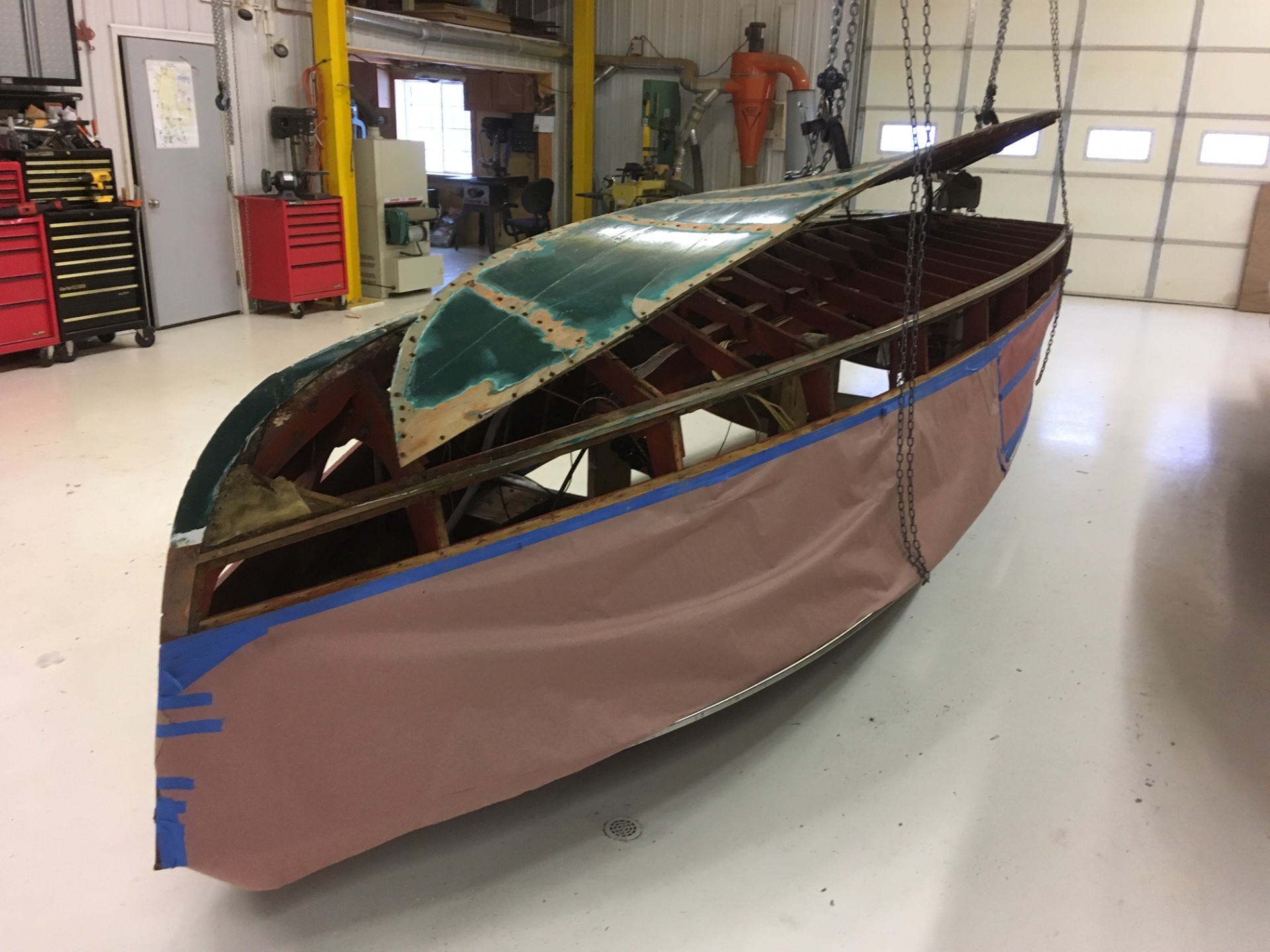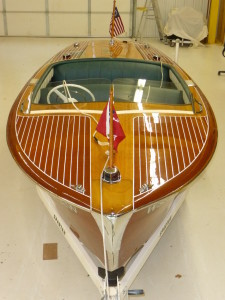Antique Wood Boat Restoration
Creating Prestigious Projects
About Us
The Okauchee Lake resident has turned a passion into a profession, making his living restoring the timeless mahogany boats at Bottoms Up, the business he runs from his home.
Chris-Craft was established by Chris Smith, one of a long line of boat builders, and was originally called Chris Smith & Sons Boat Co. By 1924 the company was making a 26-foot –long double cockpit runabout, the original Chris-Craft, bearing the distinctive dashed name in script typeface, which would become the company’s standard.
The wooden boats were produced until 1942, when the Navy’s needs during World War II turned the company’s efforts to making suitable landing for the Armed Forces. Pleasure boats production resumed in 1946.
“Today, as a result, Chris-Crafts are divided into three classifications, “ said Bunda. “Pre-World War II boats are antiques, post-war are classics and there are also reproductions. Reproductions are made to original designs, but are not original boats.
There are essentially two types: runabouts and utilities. The runabouts have one or more cockpits and a deck over the engine. The utilities have an open seating area with the engine in the center under a ‘doghouse’ cover.”
Both boats are similar at a casual glance. Wide bodied, shallow hulled, true pleasure boats, designed much less for speed than for comfortable cruising and conversation.
41 Years Ago It Ended
The last wooden Chris-Crafts came off the assembly line in 1963, a fact that contributes to the mystique of the boats today.
“It’s not that they were rare in their time,” said Bunda. “Chris-Craft was a big boat producer, more like the Chevy of boats. But there are no wooden Chris-Craft’s younger than 40 years and many are still around in their 70’s.”
Chris-Crafts’ beauty is easy to see. Sleek, shiny rich wood grain glows through layers of carefully applied varnish: they are truly crafts, vessels made with great care and workmanship. They are also an anti-techno dream.
The boats have almost no gadgets. They run off Chris-Craft’s own 6-cylinder flathead engines – often originals – so the engine may be as old as the boat.
They have three gears: forward, reverse and neutral. The dashboard has a few basic easy-to-read gauges and the steering wheels look like they come from vintage cars.
“These boats aren’t about technology; they’re about the experience. I’ve had Chris-Crafts come in that have had radios added and I take them right out. That’s not the idea of a Chris-Craft. It’s special. Every ride creates a memory and you remember every ride. And, especially it’s about the sound,” said Bunda, firing up one of the Chris-Crafts he’s been working on.
ABOUT STEVE BUNDA AND HIS LOVE OF CHRIS CRAFT
SOUNDS OF HARLEY

The engine has a deep, throaty tone, absolutely distinctive.
It reminds some people of the sound of Harleys. You can hear a Chris Craft coming before you see it. People come out and wave to you as you go by,” he said.
The ride, by itself, is special in a wooden boat. The wood is more flexible than fiberglass and gives a softer ride in choppy water.
“Everything about it is a pleasure,” said Bunda. “The sun shining off the mahogany, the beat of the engine, the smooth comfortable ride, the interest people tmahogany, the beat of the engine, the smooth comfortable ride, the interest people take in your boat. There’s nothing like it.”
Bunda owns two antique Chris Crafts runabouts, a 19-1/2 footer from 1936 and a 22 footer from 1937. He restored both – and both needed extensive restoration.
“It can take a year to completely reconstruct and rebuild a boat with new wood, stain, varnish, interior, and restored original engine,” said Bunda.

PAINSTAKING RESTORATION
Restoration is a painstaking process. No compromises can be made. The boats are made of imported mahogany planks, which must be kept at the proper degree of humidity so they are neither too loose nor too tight.
The planks must be planed to fit flush against each other, relying on a thin layer of bedding compound to retain the fit. The boat’s body is screwed together, hundreds of screws connecting the sleek exterior to the internal frame. Then, each screw must be sunk and a wooden bung made and glued into the screw hole.
Only after each hole is bunged by hand can Bunda begin the equally demanding tasks of sanding, paint colors and a special spar varnish that is resistant to ultraviolet sunrays. He will apply between 12 and 16 coats of varnish to every boat.
Each coat must be fully dry before Bunda begins the refitting process, putting back the trim, seats, wheel, gearshifts, etc.
“The refitting can take up to a week. Everything has to be exactly right,” he said.
“The refitting can take up to a week. Everything has to be exactly right,” he said.
Bunda has had boats all his life and lived on Okauchee Lake for more than 30 years. He has always loved working on his boats and has always been fascinated by Chris-Crafts.
“It started as a part-time thing, but people started asking me for help with their boats or sending their boats to me and it turned into a full-time thing. As well as repair and maintenance, I also assist with locating available Chris-Crafts,” he said.
The labor intensive process is why Bunda takes on no more than three boats at any given time.
YOU CAN'T RUSH THIS
“It’s not just time, its other variables,” he explained. “This spring, with the constant rain, has been a nightmare. Coats of paint or varnish that should have dried overnight were taking weeks instead. And you absolutely have to wait. If you put on another coat, all you do is create further problems.”
The long lives enjoyed by so many Chris-Crafts are actually testimony to mahogany, not man.
“These boats were designed to last 6 to 8 years,” said Bunda. “Chris-Craft was in business to sell boats, just like cars aren’t designed to last forever.”
But, properly maintained, mahogany is amazingly durable wood. While it’s common to put an entirely new bottom on an old Chris Craft, the sides and deck may be in good enough condition to require only stripping, sanding, staining, and new paint and varnish.
“Obviously, the sides and decks are exposed to less water. The bottom may rot, but the rest is in pretty good shape. And regular maintenance can make all the difference,” he said.
The care and maintenance Bunda lavishes on his own boats paid off handsomely in 2001. His 22-footer, named Laurie Beth for his wife, won first place in the antique and Classic Boat Society event held In Lake Geneva. Bunda has been a member of ACBS for years.
Boat lovers, especially of these increasingly rare examples, treat each boat as a treasured individual. The boats have pedigrees, if you will, which are carefully recorded

BOATS WITH A PEDIGREE
“Every boat I work on, I contact the Mariners Museum in Newport News, Va., and get a copy of its records. Using serial numbers, you can find out when the boat was made, how it was originally equipped, who signed off on it and what its original destination was. It’s fascinating to track a boat’s early life,” said Bunda.
It will come as no surprise that these old and lovingly restored and maintained Chris-Crafts have appreciated markedly in value. In June, Bunda had a 1930’s runabout in his shop for a bottom replacement. The boat, which listed for less than $2,000 in a contemporary Chris-Craft catalog, is now worth somewhere in the neighborhood of $50,000.
“As a general rule, the antiques are far more valuable than the classics. Fewer were made and fewer survive. Also, runabouts tend to be worth more than utilities, because there’s more deck surface and more fittings,” said Bunda.
The fittings are another reminder that Chris-Crafts come from another time. The seats are leather benches snugged into cockpits, which are rimmed with matching leather padding.
Internal plank walls, called seating planks, give a smooth finished look to each cockpit’s sides. The lack of gadgetry allows a passenger to admire the quiet aesthetic. Nothing swivels, no radios squawk. It’s a simple, beautiful boat, whose only purpose is to take you out to enjoying the water.
“I don’t think there’re any other boats that can draw a crowd without even being in the water,” said Bunda. “Any time I trailer one of my boats, people congregate wherever I stop. They’re just so taken with the boat and they’ve got so many questions. There’s something almost irresistible about Chris-Crafts.”
Originally Printed in the July/August 2004 of On The Lake magazine by: Amy L. Peterson